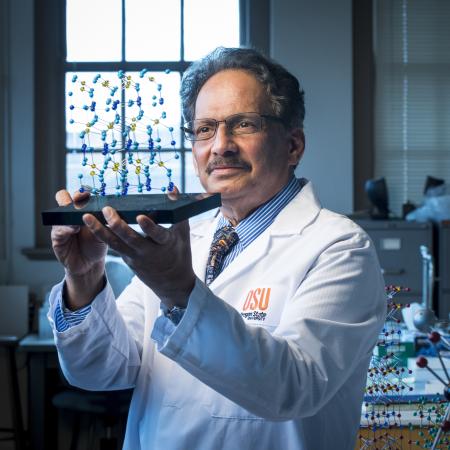Lab work plays a critical role in many scientific fields – which is why this year, as classes moved online, Oregon State’s science labs moved quickly to adapt.
"It’s been really fun,” said senior instructor Kari Van Zee, who has been leading biochemistry’s blended lab series this term. “Students are doing a good job of taking responsibility for their health and ours.”
Biochemistry Molecular Techniques (BB494) and Experimental Chemistry (CH 362) are among the few labs offered in-person this year, with instructors working quickly to ensure maximum participant safety while still providing an engaging hands-on experience. Despite the inherent logistical challenges, course instructors felt that providing students the opportunity to take the class in person would help ensure that students of all learning styles were adequately prepared for life after graduation.
“I’m really grateful to have the chance to take in-person labs this year,” said one current student. “Kari Van Zee has supported a really healthy lab environment.”
Safety in the 21st century
Facing a historic turn of events, lab instructors have test-driven a host of new COVID safety precautions. Labs have been operating at half capacity or less. “We max out at 10 students per floor, in labs that normally have a capacity of 125,” says Kevin Gable, chemistry professor and CH 362 instructor.
“Professional safety orientation has always been a key component of this course, so the COVID precautions just add another layer”
Experimental Chemistry is a lab class intended for chemistry and biochemistry majors, intended to prepare them for future careers in the chemical sciences. “Professional safety orientation has always been a key component of this course, so the COVID precautions just add another layer,” says Gable. “Fortunately, the space we have available (in part because so few other labs are in-person) allows us to spread out more than normal and keep folks safe.”
While many COVID-safety measures are already accounted for in usual lab protocol (safety goggles, gloves, fume hoods, etc.), in some cases, they’ve had to get creative. Over the summer, Van Zee personally constructed and installed individual, custom Plexiglas barriers between workstations. “I can’t imagine having done that over winter break – we needed to cut 4 x 8’ sheets of Plexiglas in the driveway!”
Of the 99 seniors taking BB 494 this winter, 79 are doing a blended rotation that allows them to alternate in-person and remote learning. Starting Fall Term, biochemistry faculty piloted a technology allowing students to take turns working in the lab group members follow along remotely via Zoom. This method also allows the 100% remote students to team up with a “blended” group and experience the lab in real-time.
BB 494 is a two-part research-based course required for all seniors in the biochemistry department that helps provide critical experience for future pathways in medical research, pharmacy, biotechnology and chemical industries. This term, students are designing and carrying out research projects focused on the biochemistry of the protein nitroreductase, which has medicinal and industrial applications, explained Van Zee. They also get the chance to use genetic code expansion technology for protein engineering, courtesy of the Unnatural Protein Facility run by biochemistry professors Ryan Mehl and Rick Cooley.
Redefining remote
Given OSU’s renowned Ecampus program, online science courses were already ahead of the curve before the shutdown. Now, labs are innovating new ways for students to take science home with them.
A generous donation to the physics department provided funding for take-home kits, assembled by physics professors David McIntyre and Matt Graham, for upper-level physics students to gain hands-on experience.
Working with the College’s IT services, the course instructors set up access for students to log in remotely to lab computers and control high-tech machinery. “In some cases, they built the same experiment at home and then logged in remotely to perform measurements with more sophisticated equipment,” McIntyre explained.
"Our students have shown amazing resilience and adaptability throughout all the changes, and I'm confident we could teleport them into an in-person lab and they'd be running experiments in no time!"
Microbiology instructor Allison Evans has used a similar hands-on approach in MB 303, a two-credit lab for microbiology majors. “Some of the strategies we have used to give students a hands-on experience from home include having students make their own Winogradsky columns and following their development for 9 weeks, cooking their own media at home using gelatin, sampling microbes from their home, and recording videos of themselves demonstrating proper aseptic technique,” she said.
“Although we aren’t able to replicate all aspects of the in-lab experience, we are happy to be able to deliver all the elements that students taking the lab in the usual format are able to experience,” said Evans.
For Kenton Hokanson, it was important to capture the “busy, loud and fun” spirit of the introductory microbiology lab MB 230. With the course description “Microbiology as it affects our everyday lives,” he showed students how to culture microbes from their home environment, and apply laboratory techniques to analyze them.
"Our students have shown amazing resilience and adaptability throughout all the changes, and I'm confident we could teleport them into an in-person lab and they'd be running experiments in no time!"
Even with the unexpected challenges, professors see a silver lining in the changes the pandemic has brought to teaching in higher education.
Van Zee expects that the new remote-learning technology will help make classes more accessible for every type of learner, even after they return to in-person teaching. “Previously students withdrew from class if they needed to leave for too long,” she says. “We only offer this class once each year, so that delayed graduation.” Making lectures available over Zoom will allow students who commute or have families to attend remotely.
“We are all learning new ways to be flexible, creative, collaborative and appreciative,” said Van Zee.



